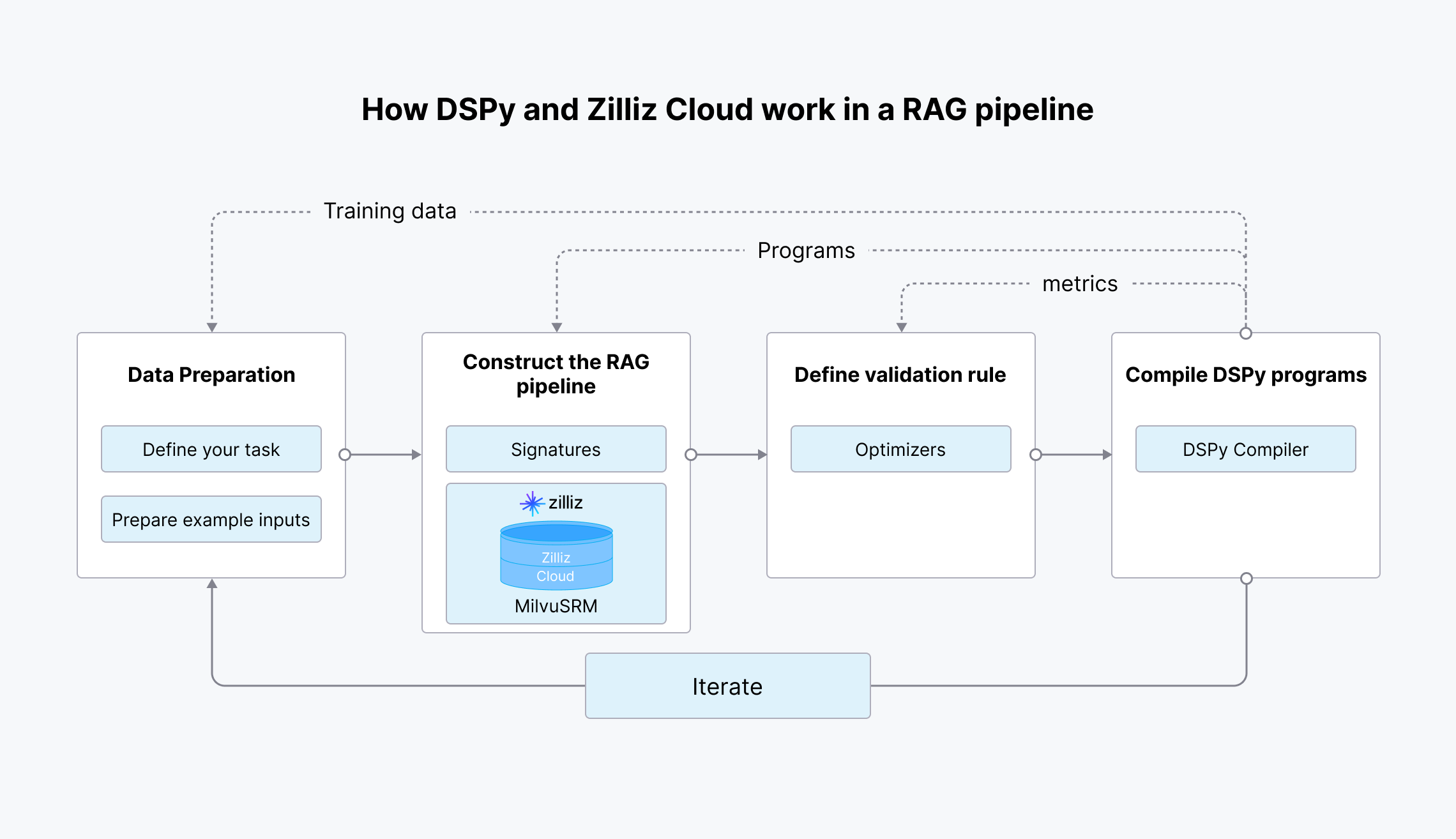DSPy
Building high-performance Retrieval Augmented Generation (RAG) pipelines with DSPy and Milvus or Zilliz Cloud
Use this integration for FreeWhat is DSPy?
DSPy is a programmatic framework designed to optimize prompts and weights in large language models (LLMs). It provides various composable and declarative modules for instructing LLMs in Pythonic syntax. DSPy is particularly useful when LLMs are integrated across multiple pipeline stages when building your GenAI systems.
Unlike traditional prompting engineering techniques that rely on manually crafting and tweaking prompts, DSPy learns query-answer examples and imitates this learning to automatically generate optimized prompts for more tailored results. This approach allows for the dynamic reassembly of the entire pipeline of your AI applications, explicitly tailored to the nuances of your task, thus eliminating the need for ongoing manual prompt adjustments.
Benefits of the DSPy and Milvus/Zilliz Integration
Both DSPy and Milvus/Zilliz are essential AI technologies for building GenAI applications, especially Retrieval Augmented Generation (RAG). Integrating Milvus and Zilliz Cloud (the managed Milvus) into the DSPy workflow via the MilvusRM Client allows developers to harness Milvus' efficient similarity search capabilities alongside DSPy's programmatic prompt optimization techniques. This powerful combination results in significantly more efficient and effective RAG pipelines.
The DSPy and Milvus/Zilliz integration offers two key benefits:
Simplified RAG Implementation and Configuration: Building RAG pipelines involves navigating the nuances and complexities of setting up components and workflows, particularly with LLMs and retrievers. The DSPy and Milvus/Zilliz integration streamlines this setup process by programmatically automating the optimization of vector retrieval, prompt design, and LLM fine-tuning, reducing the need for manual adjustments.
Improved RAG Performance and Scalability: Milvus is a powerful open-source vector database known for its high performance and scalability. Zilliz Cloud is the managed Milvus with even higher performance. Integrating Milvus/Zilliz with DSPy ensures efficient handling of large-scale data retrieval operations, making RAG applications more robust and capable of managing extensive datasets.
Overall, the integration of DSPy and Milvus/Zilliz provides developers with a powerful, efficient, and scalable solution for building high-performance GenAI applications that leverage the strengths of both technologies.
How the DSPy and Milvus/Zilliz Integration Works
Milvus has been integrated into the DSPy workflow as a retrieval module. The diagram below shows how this integration works in a RAG pipeline.
 How DSPy and Zilliz Cloud work in a RAG pipeline.png
How DSPy and Zilliz Cloud work in a RAG pipeline.png
- First, you define your task and prepare a few example inputs—often without labels (or solely with labels for the final outputs, if your metric requires them).
- Second, construct your RAG pipeline using the MilvusRM module, assigning it a signature (input/output specification), and seamlessly incorporating the MilvusRM into your Python code.
- Third, define the validation logic for your RAG pipeline, including what metrics and example inputs to use to evaluate the quality of prompts and the final results.
- Fourth, compile your code using a DSPy optimizer, which generates high-quality instructions, automatic few-shot examples, or updated LLM weights.
- Finally, engage in an iterative process of refining your dataset, program, or validation logic to achieve the desired performance level for your RAG pipeline. Continuously assess and improve to meet evolving requirements and optimize results.
How to Use DSPy with Milvus/Zilliz Cloud
Milvus Documentation | Integrate Milvus with DSPy
Blog | Exploring DSPy and Its Integration with Milvus for Crafting Highly Efficient RAG Pipelines
Blog | How to build a Retrieval-Augmented Generation (RAG) system using Llama3, Ollama, DSPy, and Milvus
Discord | Join the Milvus Discord Community with AI Developers